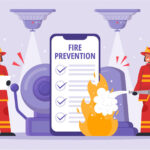Tips For Emergency Evacuation Planning
Evacuation plans let representatives know precisely where to follow to leave the building. Instead of isolating to various sides of the building, or floating to their vehicles, the arrangement tells the staff where they are required to be, and when they are relied upon to be there after the evacuation starts. Remaining together after an evacuation is significant because it empowers the head counters to get an exact record of every individual who ought to have left the business premise, and helps the head counters pass along data to crisis faculty about the number of individuals left in the structure, and where those individuals may be.
TIPS FOR AN EFFECTIVE EVACUATION PLAN
Regardless of whether you’re a little physical store or a developing global enterprise, great crisis departure arranging or emergency evacuation plans are an acceptable business practice. Given below are some tips which will make your workplace better, safe and secure.

- Make a General Crisis Activity Plan: Evacuation will be best when their techniques are created as a component of your business’ far-reaching crisis activity plan. The motivation behind a General Crisis Activity Plan is to put together every crisis move, an company makes previously, during, and after a work environment crisis. This incorporates everything from preparing to characterizing how a crisis is announced, to departure systems, through rebuilding methodology. An all-around evacuation planning will lessen harm to the business foundation.
- Arrange with Crisis Administrations: Incorporate agents from nearby law requirements, fire, and crisis clinical administrations in your arranging cycle. They have a personal stake in how your company reacts to crises. They will know best what you may have neglected or what extra advances they need you to take to guarantee staff wellbeing. If your company is situated in a multi-inhabitant building or a business park, you may think that it’s helpful to organize your arrangement with adjoining organizations. You might have the option to share some crisis reaction obligations when everybody is influenced. In any event, planning with neighbors will guarantee you’re not going to meddle with every others’ departures.
Make Evacuation Routes and Points: Determining the safest possible route is important. Avoid routes that will take your employees towards hazards. Evacuation Route maps need to have a clear and concise route map that will help to navigate quickly and effectively. For example, the routes need to avoid being through any flammable storage unit. Need of a meeting point after evacuation is also needed to be established. This will ensure the number of employees who have been successfully evacuated and those who have not. It will also help to get first aid to those who require first aid.
Have the Correct Instruments Available: Think about whether some or all of your workers will require individual defensive hardware to clear securely. This might be essential relying upon the sorts of crises your company is probably going to confront or relying upon the likely dangers in various places of your office. Reasonable defensive hardware could include:
- Hard caps
- Security glasses
- Ventilators or respirators
- Compound hoods, suits, gloves, or boots
Protect Each Person in Your Office: Your departure plan needs to ensure something other than your representatives. You’re liable for any project workers and guests in your office, as well. Your arrangement additionally ought to consider the requirements of the crisis administration workforce that will show up. Your evacuation plan needs to incorporate methodology for aiding people who may require exceptional help.
Effective Evacuation Planning is the best tool for a business to have. It helps to keep clients and employees safe and secure.
Subscribe to get Latest Blogs
Recent Posts
-
 5 Essential Fire Safety Measures Every Facility Needs: A GuideApril 6, 2024/0 Comments
5 Essential Fire Safety Measures Every Facility Needs: A GuideApril 6, 2024/0 Comments -

-
 Elevating Workplace Safety: Why Every Office Needs CCTVFebruary 17, 2024/
Elevating Workplace Safety: Why Every Office Needs CCTVFebruary 17, 2024/ -
 Fire Drills and Beyond: Navigating Workplace Fire Safety ProtocolsJanuary 18, 2024/
Fire Drills and Beyond: Navigating Workplace Fire Safety ProtocolsJanuary 18, 2024/
